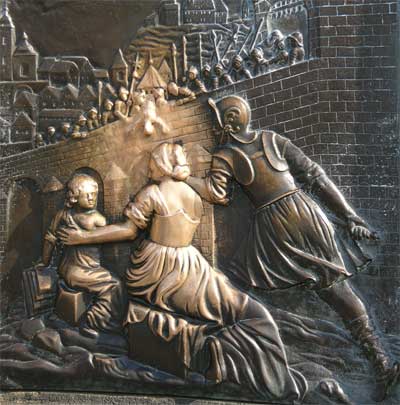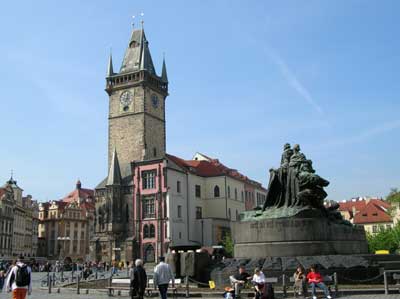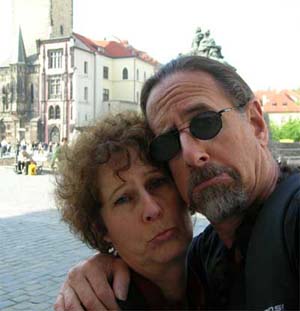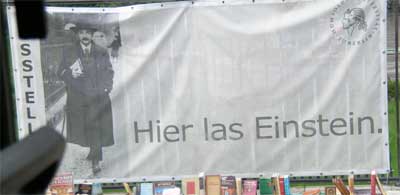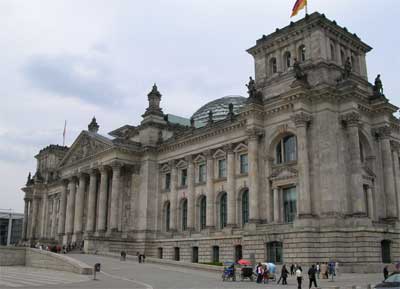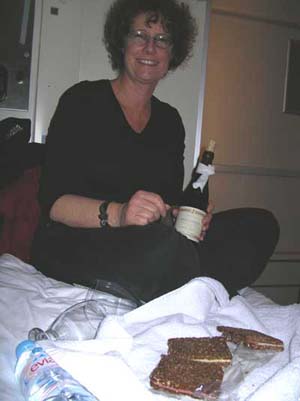|

|
|
|
|
about us |
|
|
see the beast |
|
|
our photo album |
|
|
explore tucson |
|
|
links |
|
|
email us |
|
|
sign our guest book |
|
|
home |
|
www.davidandcarol.com |
Our Magnificent
Journey |
Chapter 6 |
Europe 2005 |
London, Paris, Normandy, Prague |
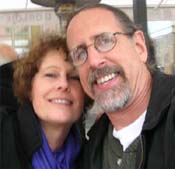 |
|
We both slept very well. The cool Prague night air drifted in through the open windows and we were so comfortable in the generously large, soft, queen-sized bed. The Maximilian is terrific and we highly recommend it. | ||
|
||
Last breakfast at the hotel was delicious. We are sorry and sad to leave. We have thoroughly enjoyed our time in Prague. |
||
|
||
We walked in the early morning sunshine, skirting Old Town Square, aiming for Karluv Most (Charles Bridge) to take in one last panoramic view of the Vlatava and both picturesque banks. We both rubbed the plaque of St. John Neponuk for good luck. |
||
|
||
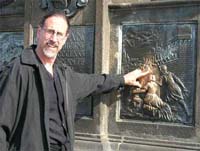 |
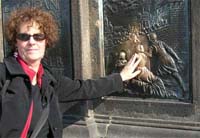 |
|
|
||
|
||
|
||
|
||
|
||
|
||
|
||
As usual for the traveling Lehrmans, we are sad to leave this ancient, beautiful, romantic Old-World place. Europe, for us, in many places, is not unlike a time machine. We were surprised at the remnants of the communist regime – mostly architectural. In Prague, you are presented with the flavors/memories of the medieval times, mingled with those of the Nazis, mingled with those of the Communist era, mixed in with the influences of the West. Prague transported us back to a time and place where life was mysterious, charming, innovative, earth-changing and rustic. We certainly could have spent much more time here, and we hope to return. |
||
|
||
|
||
We checked out of the magnificent Maximilian, thanked the staff and took a taxi the short distance to the Prague main train station. Always, the trains of Europe fascinate us – ever since my first trip in 1971 and Carol's first trip in 1978. We love to read the destinations as we walk between platforms – Moscow, Vienna, Hamburg, Linz, Warsaw, Krakow, Dresden. Unlike in the US, the European trains still hold a dominant role in getting you from one place to another. |
||
|
||
Note: Our observation of the Prague citizens as a generalization – cool, aloof, impatient and bothered by the hordes of tourists. Of course there were exceptions but we found the Czechs to be noticeably more distant than we had expected. Some vendors and waiters were downright rude. There are surely cultural reasons for this. We have found the French and the English to be very approachable and accommodating. I have to say that the staff at Hotel Maximilian went beyond the call of duty, without exception. |
||
|
||
The train pulled out of Prague, capital of Bohemia, exactly on time at 11:18am, and wound slowly north, passing small Czech towns and farms and many beautiful rivers and streams, lots of wooded areas and picture-postcard settings. It is overcast but warm. |
||
|
||
|
||
We arrived at the Czech border town of Decin at 1:00pm. We are sad to be leaving the mystical, magical and historical Czech Republic, but before us lie Germany and France. |
||
Crossing into Germany, the train continued north along the Elbe River. Very hilly and picturesque countryside. First stop was Bad Schandau. Eventually we entered Dresden, a large German industrial city that was firebombed by the Allies in WWI. |
||
Pulling out of Dresden we passed rolling fields of bright yellow. Through many small villages – lots of people tending gardens and flocks. Lush, wooded areas. More vast fields of yellow. |
||
|
||
Stopped for a few minutes at Berlin Schoenfeld Flughafen (airport). Finally at 4:30pm the train slowed to a stop at Berlin 's Ostbanhof Station, where we hopped off, having spent a relaxing afternoon watching the Czech and the German countryside flow by. We stowed our luggage into a locker, and discovered out that we needed to relocate ourselves to Alexanderplatz, a lively stop beneath a massive communications tower. We immediately ducked into a tourist information center and told the young German fellow that we have 5 hours in Berlin (our train to Paris leaves at 9:30) and want to see the main sights and asked what he would suggest as a plan of action. He suggested that we buy the day transportation pass and take the #200 bus through East Berlin. We saw quite a bit from the bus, then jumped off at the zoo and changed to the #100 bus. We then jumped off at the stop for the Reichstag, Bundestag and Brandenburg Gate. Walking to the Brandenberg Gate we saw a memorial to the many people, young and old, who died trying to cross from East Berlin to West Berlin and freedom. At the historic gate, there was a display outlining its history. It was here that East met West and here where the wall came tumbling down. It was emotional for us, as it was for many others. We walked back to the bus stop and marveled at the massive size of the Bundestag. Then back to Alexanderplatz and back to Ostbanhof, where we enjoyed unbelievably delicious riesencurrywurst and sauerkraut and Berliner Kinol Beer. Boy, did that hit the spot and oh so German. We are so glad to have been here even if for a few hours. Traveling like this – taking chances – is not for the weak of heart, but worth every second. |
||
 |
||
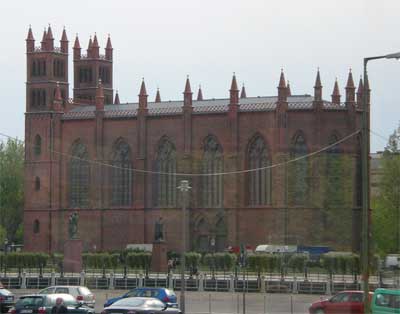 |
||
|
||
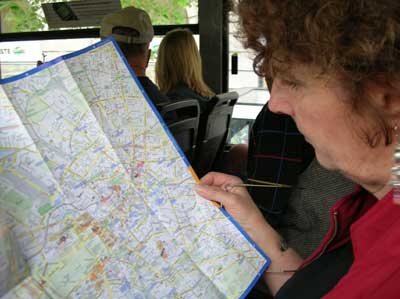 |
||
|
||
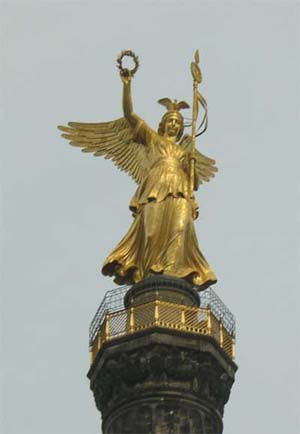 |
||
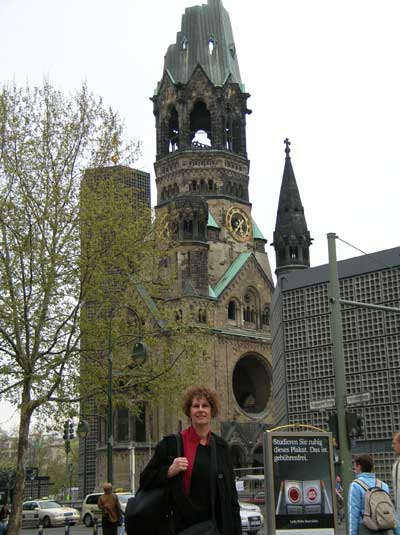 |
||
|
||
|
||
 |
||
|
||
|
|
||
|
||
|
||
|
||
As we sat enjoying our Germanic feast and reflecting on the day's events, I decided to call brother Jim (my first trip to Europe was with Jim in 1971) to get an update on Cassidy – his daughter, my niece – who has just landed a role in the HBO series “Entourage”. According to Jim, it sounds like her career is starting off like a rocket. She is incredibly talented and we wish her the best of luck. We have a hunch she will be a star – she has been entertaining us since she was quite small. You go, girl. |
||
|
||
We are in a large, busy train station in one of the world's largest, busiest cities and there are dogs everywhere. Europe is about as dog-friendly as can be and we love it. But it makes us stop and think about Cody, who is in great hands with Noelle and Megan. |
||
|
||
We watched the ingress and egress of people at Berlin 's Ostbanhof until 9:25 when the overnight train to Paris arrived and we boarded. We found our tiny but cozy overnight compartment and settled in for a 12-hour train ride through Germany, Belgium and France. A typical David and Carol adventure. |
||
The history of Berlin is relatively “new” as far as the capitals of Europe go, and is fascinating. Two founding towns, Colln and Berlin, joined in 1307. Several Friedrichs ruled from the 1400s to the early 1800s when Napoleon's troops occupied the city. In 1871, Berlin became the capital of the “Deutsches Reich” and the economy grew as well as the population. Riots after the defeat of WWI created a crisis and the Republic was proclaimed in 1918. In spite of riots and social/economic crises, arts and culture flourished in the 1920s. Berlin was the center of the “Golden Twenties”. Hitler's takeover in 1933 and the murder of Jews and “non-Aryans” marked a time of terror. The city was devastated by the end of WWII, and the four allies divided Berlin into four parts: the East was administered by the Soviet Union, the Southwest by the US, the West by Great Britain and the Northwest by France. Suddenly Berlin became a “front line city” – and at the same time became a symbol of freedom. This was the start of the Cold War, the conflict between the free system of the west and Communist system of the Eastern Bloc. Angered by the dispute, the Soviet Union blockaded the 3 western sectors from June 24, 1948 until May 12, 1949. The US initiated a gigantic and successful air lift. |
||
|
||
On August 13, 1961 East Germany created what came to be known as The Wall. There were many deaths as people tried to flee East Germany for the freedom of the west. Border guards were ordered to shoot on sight at any East Berliners attempting to flee. |
||
President John Kennedy visited on June 26, 1963 and helped raise morale. In 1970 the Soviet Union showed a willingness for renegotiation. In the 1980s it became clear that East Berlin and the Soviet Union in particular, were in decline. Unrest continued. In Prague, a student named Jan Pavlach committed suicide by burning himself to death in order to further draw the world's attention to the Soviet oppression. This led to the “Velvet Revolution” and on Nov. 9, 1989 the Wall was torn down. Unity came into effect on Oct. 3, 1990. Berlin once again is truly the capital of Germany. |
||
We were in Berlin 60 years to the day that Hitler committed suicide in his bunker under the Reich Chancellory. |
||
|
||
The train pulled out of Berlin at 9:30pm and Carol and I settled in to explore our little cabin. The bunks were surprisingly comfortable and we toasted this adventure with a half bottle of wine. We drifted off to sleep and the hypnotic motion of the train acted as a sedative. |
||
|
||
|
||
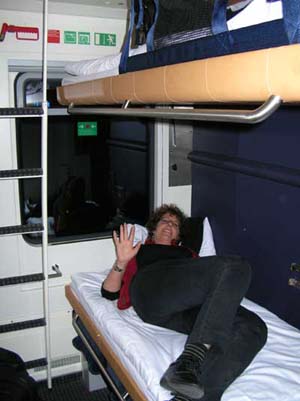 |
||
|
||
| In a few short hours we'll be back in our beloved Paris... | ||
Pedometer reading for today - 7.25 miles |
||
| Previous Day |
copyright 1998 / david
and carol lehrman / all rights reserved |
email david@davidandcarol.com |
